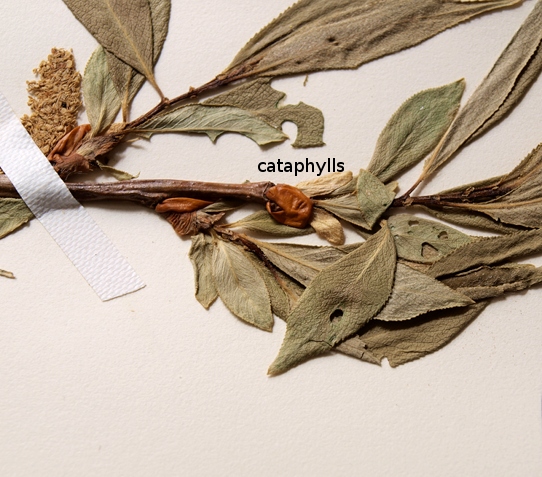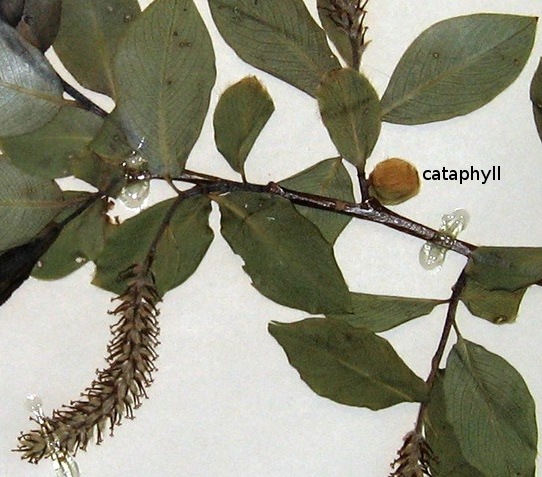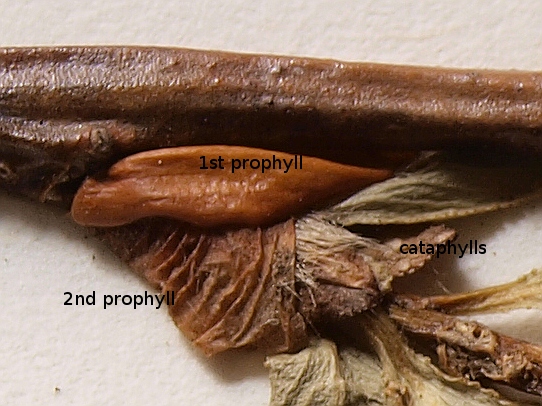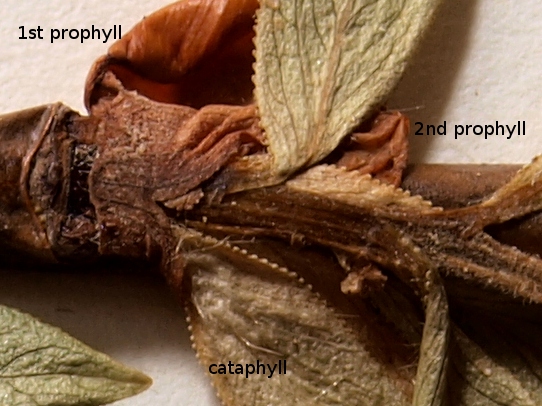|
In memory of A.K. Skvortsov (9 February 1920 — 8 May 2008)
Identification of Salix lucida Muhl. |
|
|
In most cases, Salix lucida Muhl. can be reliably distinguished from other willows by its dark green, strongly lustrous leaves with caudate apices and well developed stipules; by the presence of trichomes on young leaves and sometimes even on branchlets and buds. Usually at least some of the hairs are reddish, which is never observed in related willows. Nevertheless, S. lucida can be confused with Salix serissima (L. H. Bailey) Fernald, S. euxina Belyaeva, S. pentandra L. S. lucida can be distinguished unmistakably in spring or even during the winter by the bud structure, which was demonstrated 50 years ago by A.K. Skvortsov (1960) in his review of the species group of Salix pentandra. The named willows belong to three different species-groups within the subgenus Salix. In the species of lucida-group (S. lucida and its western counterpart, S. lasiandra Bentham) the cataphylls are elongate; while in pentandra-group (including S. pentandra and S. serissima) as well as in S. euxina and its hybrids (S. x fragilis) from alba-group the outermost primordial leaf (cataphyll) is very broad, oval or nearly roundish, embracing the entire bud content in mature buds (Skvortsov 1955, 1960: Fig. 1). In S. pentandra and S. serissima the outermost cataphylls are glabrous on both sides, though with trichomes at margin. While their marginal trichomes are caducous, the roundish pale cataphylls are frequently preserved in herbarium samples, at least in S. pentandra. The shape of the cataphylls in the species of alba-group, including S. euxina, is similar, but they may be entirely covered by white trichomes on the upper surface, while in Salix lucida the cataphylls are narrow, with unusually long trichomes arranged medially on the upper surface. |
|
|
Salix lucida

Massachusetts: Berkshire Co., Egremont, B.A. Sorrie, C. Caljouw, 3787 (NEBC).
Originally identified as Salix serissima; however buds and cataphylls of Salix lucida type,
stipules well developed and young leaves with reddish hairs (not visible at the photo).
|
Salix pentandra x S. euxina ?

Massachusetts: Worcester Co., Templeton (NEBC, another duplicate in
College of the Holy Cross, Worcester).
It cannot belong to Salix pentandra,
as it was initially identified,
because stems were
"very brittle at base".
|
|
The bud scales in S. lucida remain alive during the winter, i.e., do not die off and thus may be frequently retained in the herbarium material collected in spring (Skvortsov 1999: 47). This feature makes S. lucida different from S. euxina, S. pentandra, and S. serissima. In S. lucida, the second prophyll (the inner membranaceous layer of the bud) is free. It is separated from the outer layer, yet connected to the base of the developing shoot by a narrow ring. It partially embraces and covers the developing cataphylls together with long silvery tufted trichomes spreading from the shoot origin and medial parts of cataphylls. These characters appear to be quite stable in all examined material, though I cannot confirm it for northernmost populations usually identified as S. lucida var. angustifolia; perhaps they deserve a special study. |
|
|
Salix lucida


Same specimen as above, details
|
|
|
S. lucida has a rather broad distribution in eastern North America (Argus 2010, USDA Plants Database, 2010, as S. lucida ssp. lucida) reaching south to Delaware, Maryland, and West Virginia. A disjunct population is known even in Virginia, though there it is considered escaped from cultivation (Argus 1986: 67). The southernmost specimen I have examined originated from Maryland: Laurel, W. L. McAtee, May 20 1928, 3391 (US). This is a new record for the Flora of D.C. and Vicinity (barcode 00387062). Originally it was identified as S. pentandra, but its reddish trichomes, well developed stipules, the bud structure, and cataphylls are typical for S. lucida. I observed live S. lucida in Canada, particularly along the Ottawa River. I have examined more than a hundred herbarium specimens of S. lucida from the College of the Holy Cross, Harvard University Herbaria, and Smithsonian Institution (NMNH). I am grateful to Robert Bertin, Emily Wood, and Rusty Russell for the opportunity to examine these willow collections. This work could not have been completed if the morphology of this group had not been studied 50 years earlier by A.K. Skvortsov (1960, 1999). References
Argus, G. W. 1986. The genus Salix in the southeastern
United States. —
Syst. Bot. Monogr. 9: 170pp.
Argus, G. W. 2010. Salix — In:
Flora of North America Editorial Committee, eds. 1993+.
Flora of North America North of Mexico.
12+ vols. New York and Oxford.
Vol. 7.
Skvortsov, A.K. 1955. The willows of Central European Russia and their identification during the wintertime.
— Byull. MOIP, Otd. biol. 60 (3): 115-127.
In Russian.
English translation:
http://salicicola.com/translations/Skvortsov1955.html
Skvortsov, A.K. 1960. Salix pentandra and related species. — Trudy MOIP 3: 247-262. In Russian.
Skvortsov, A.K. 1999.
Willows of Russia and adjacent countries.
(English translation of Ivy SSSR, 1968, with additions.)
Joensuu (Finland): Joensuu Univ. Press. 307 pp.
Available at salicicola.com in PDF format.
USDA, NRCS. 2010. The PLANTS Database
(http://plants.usda.gov, 9 July 2010).
National Plant Data Center, Baton Rouge, LA 70874-4490 USA.
Note
|
|
|
Alexey Zinovjev (15 July 2010 )
|
|